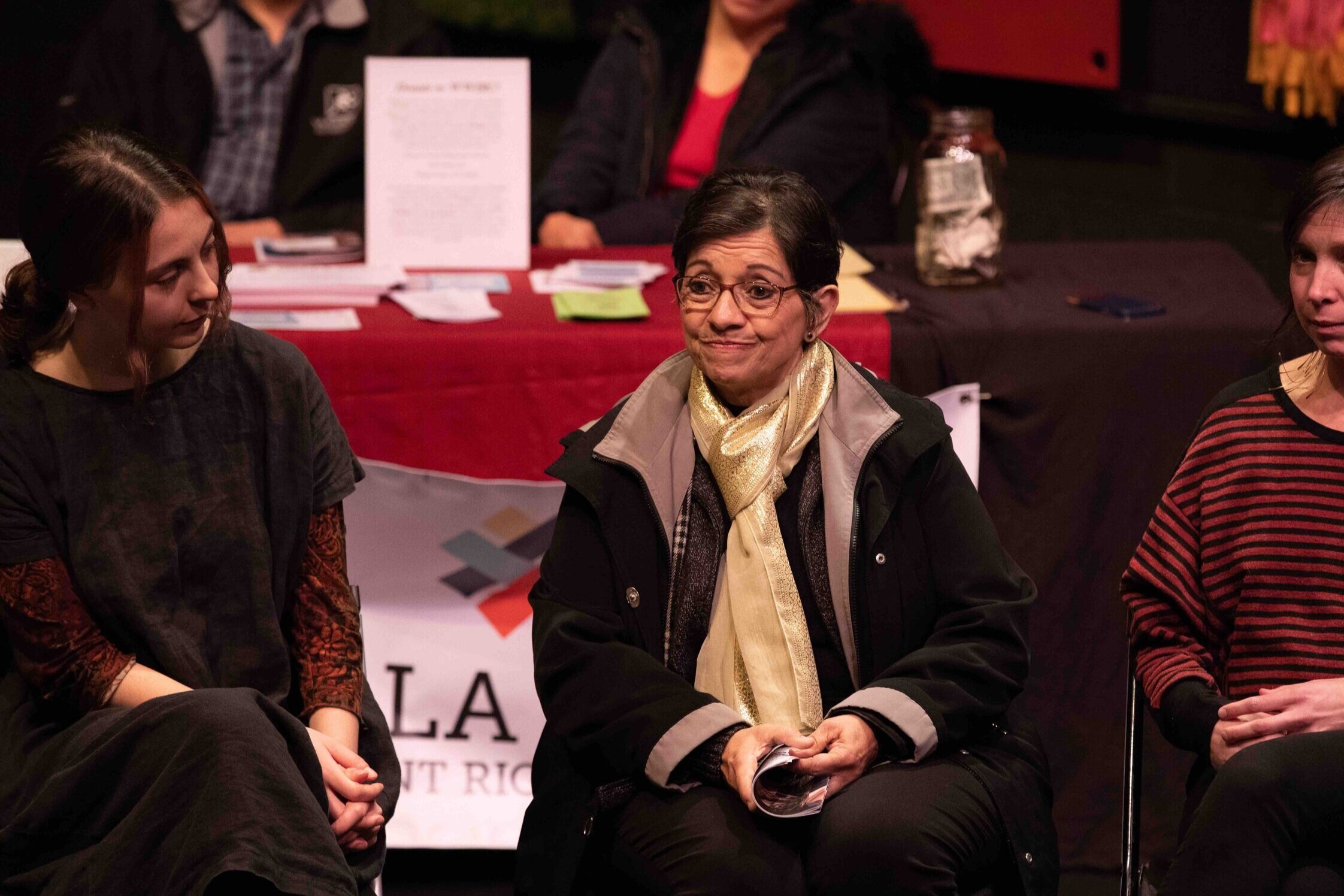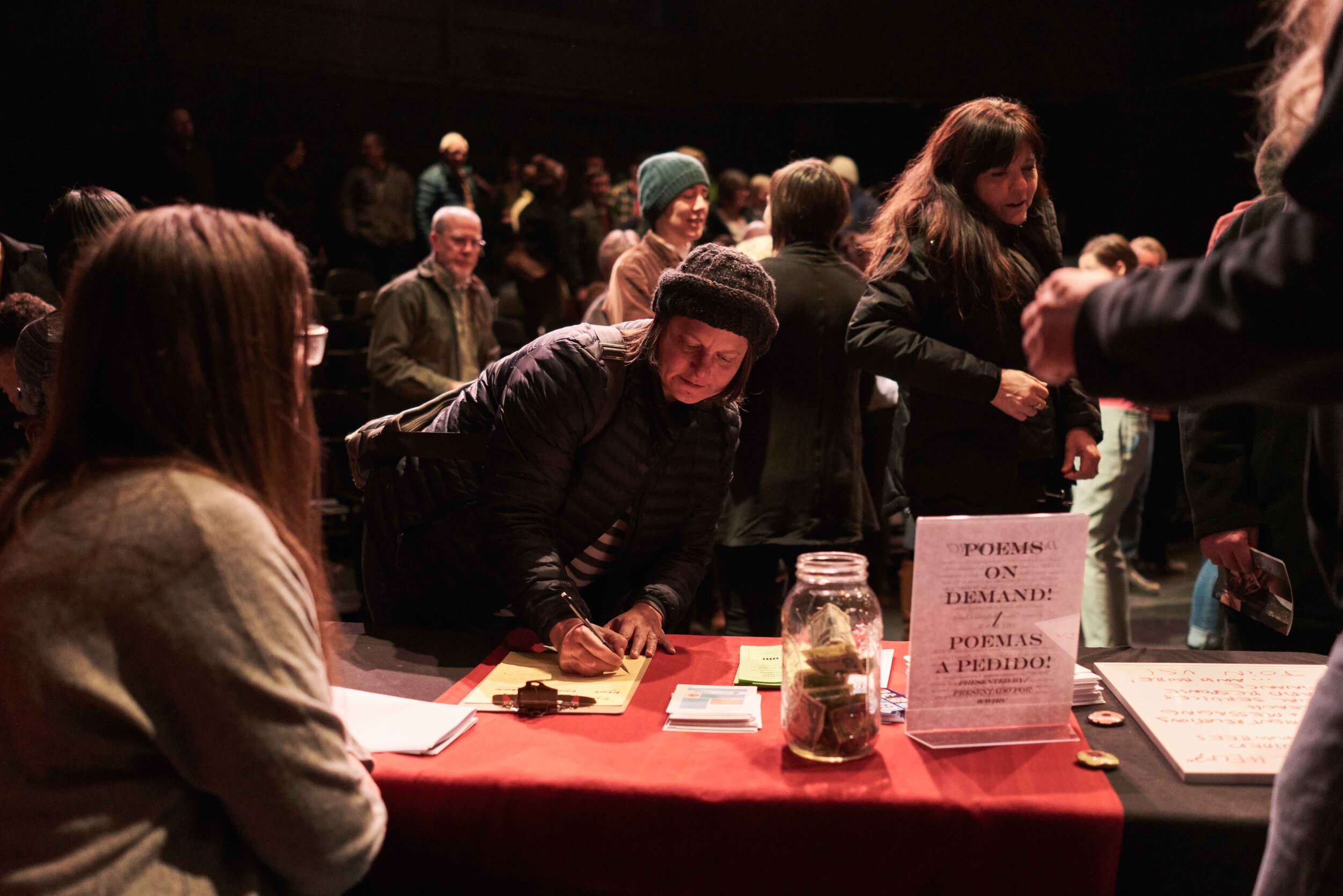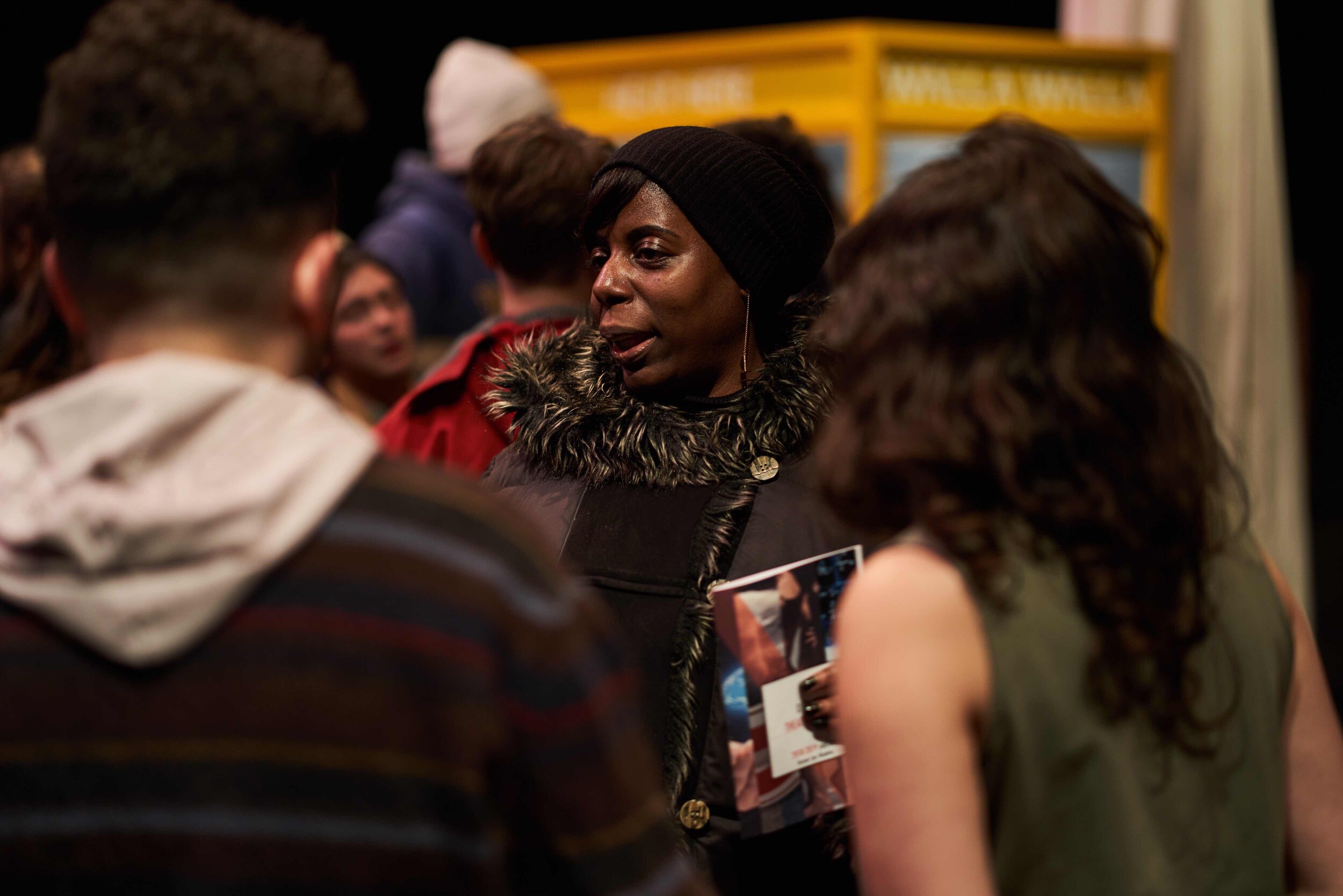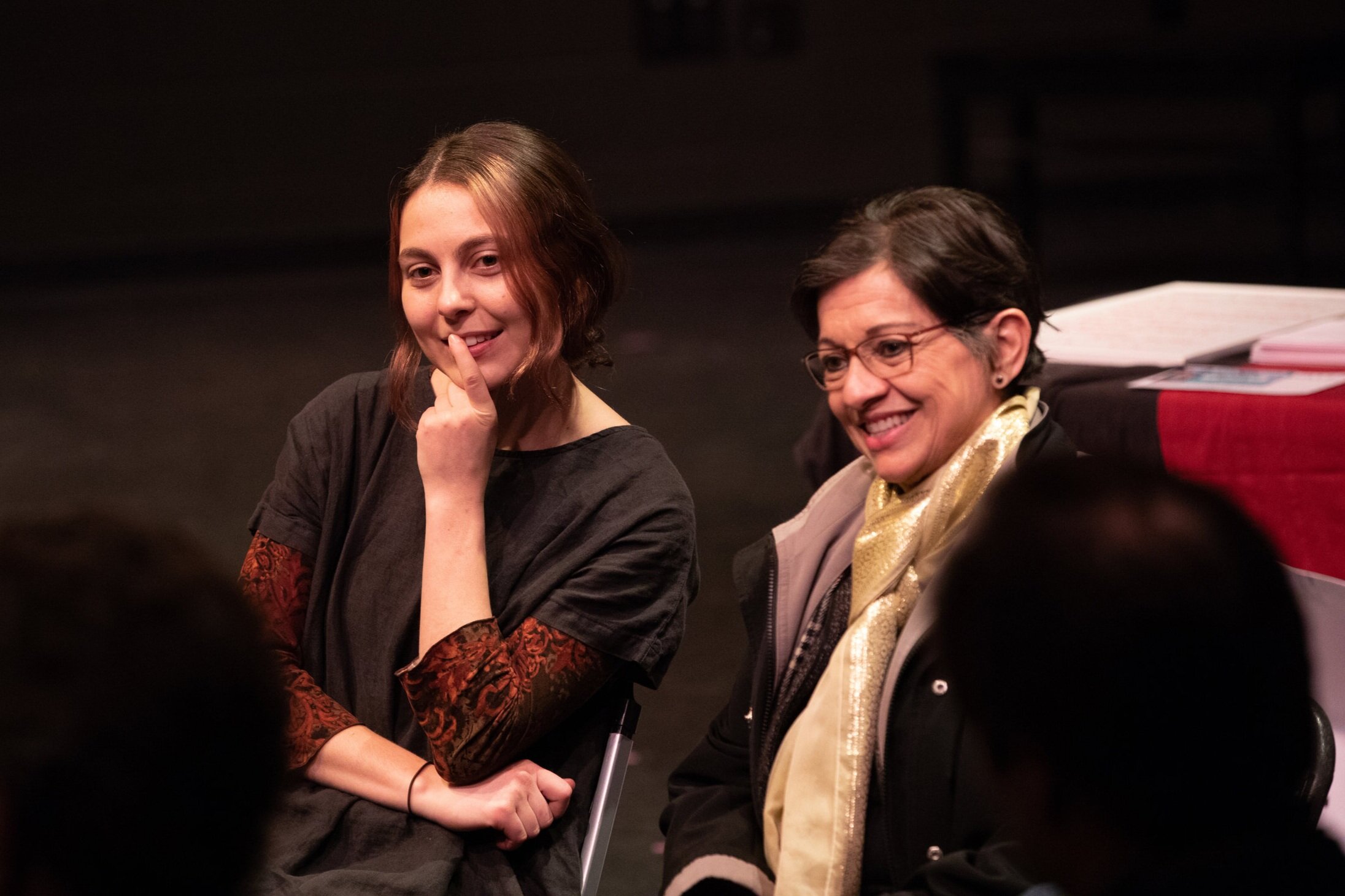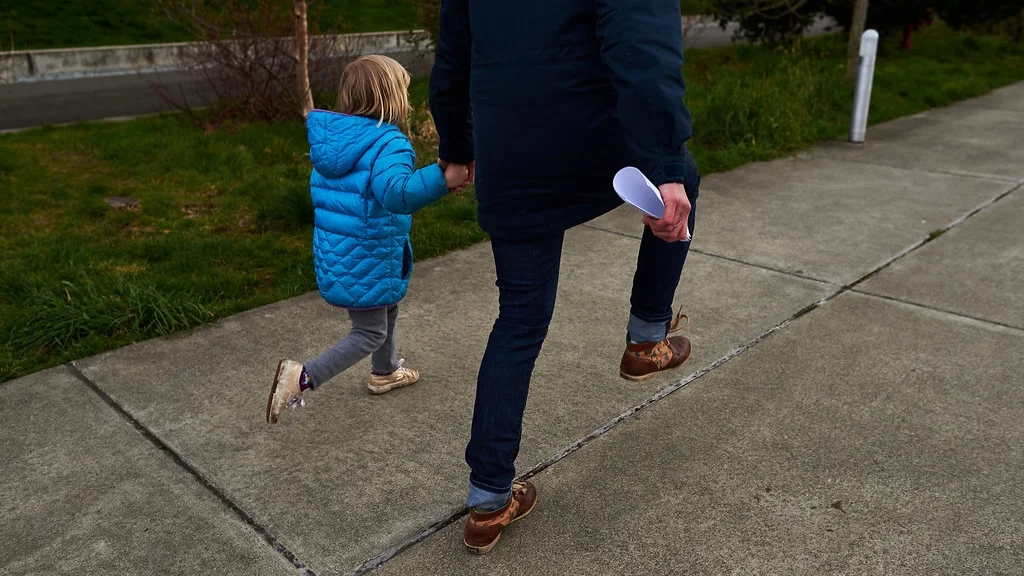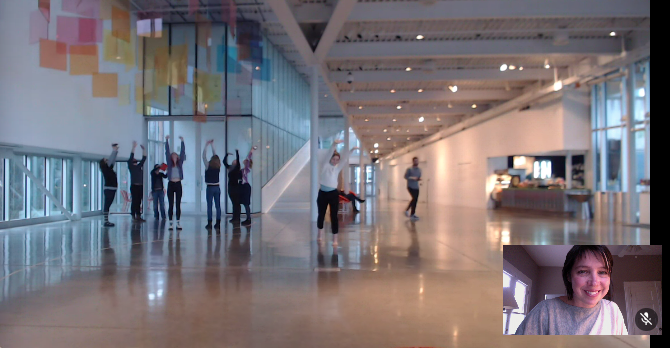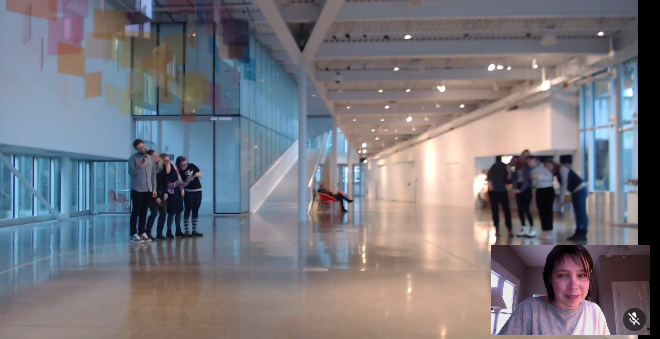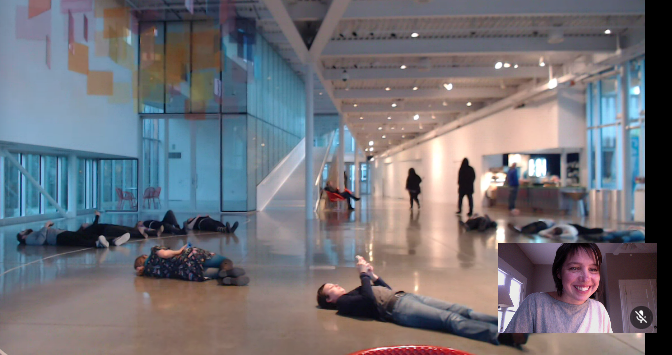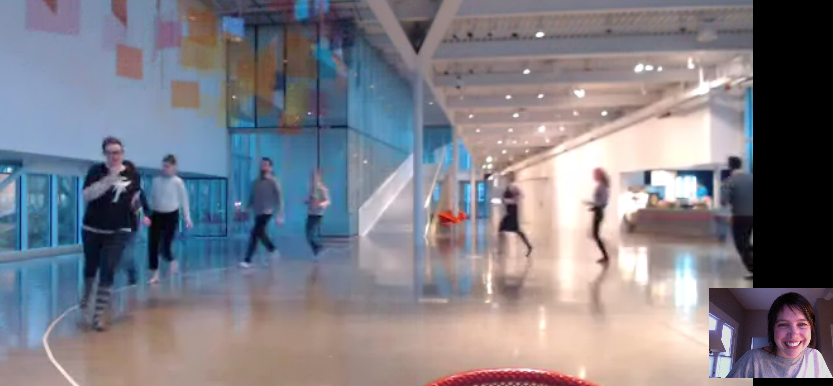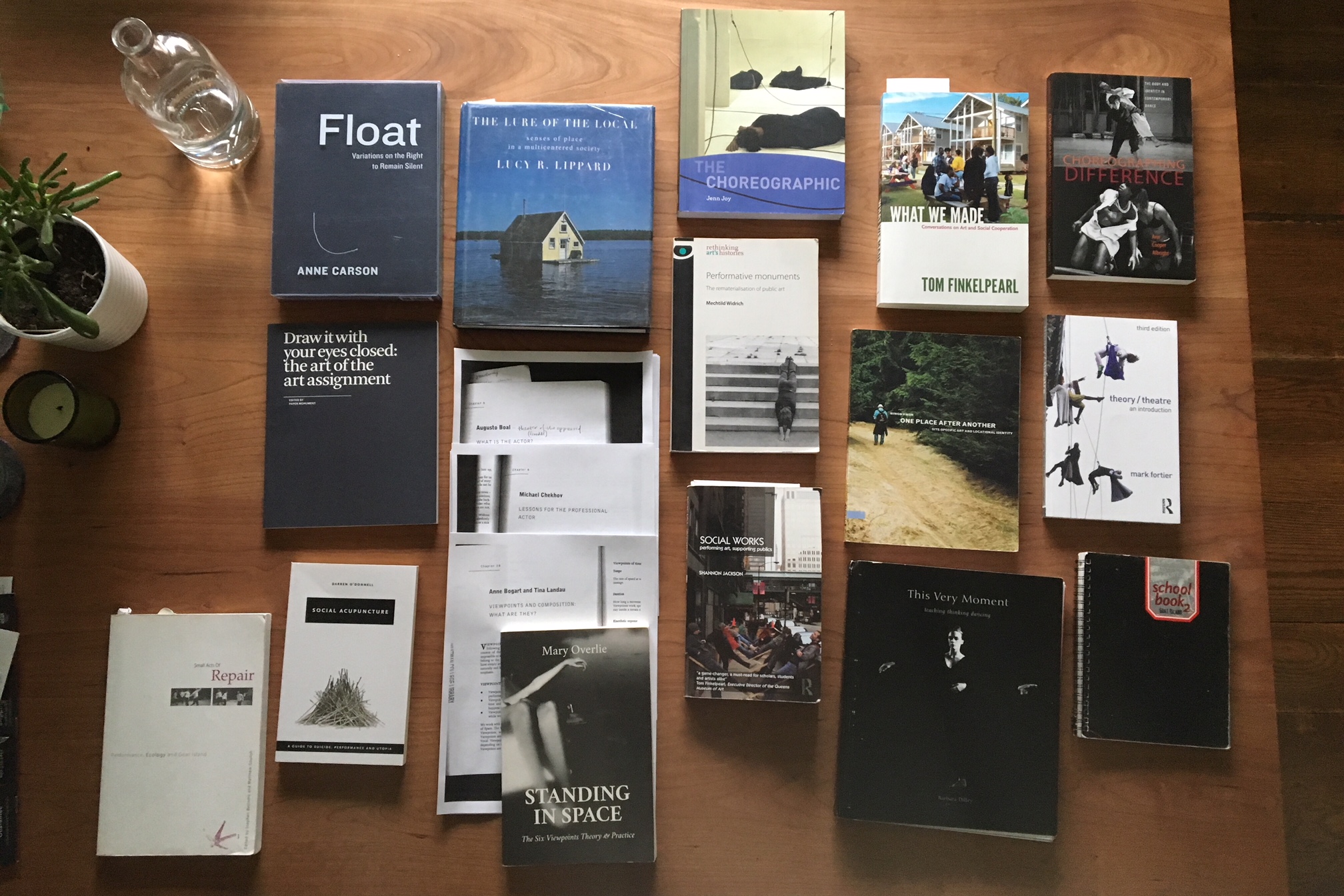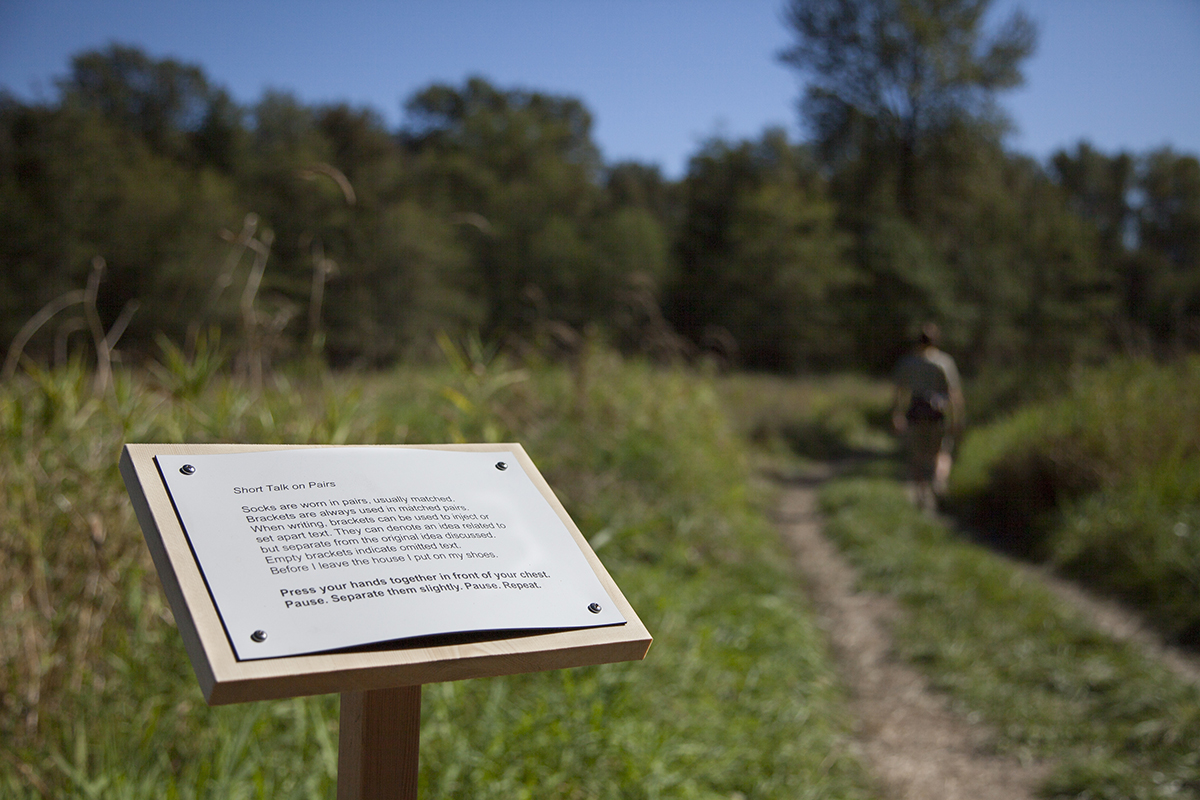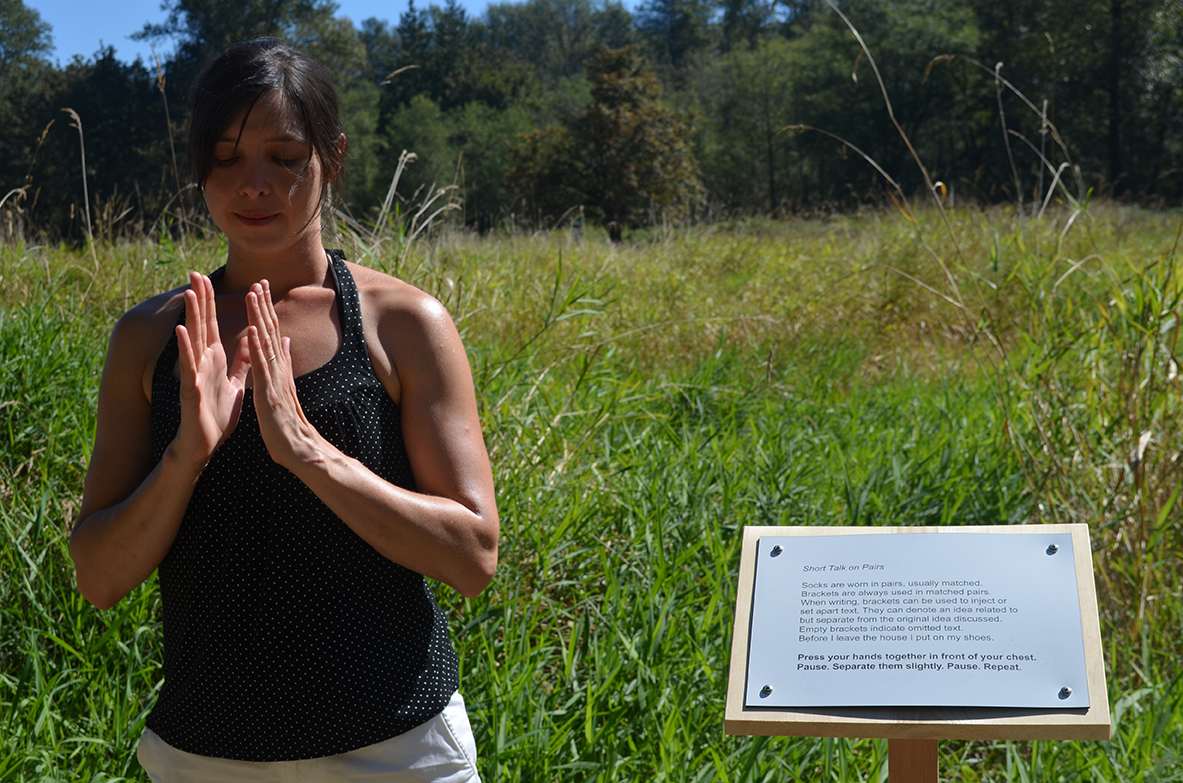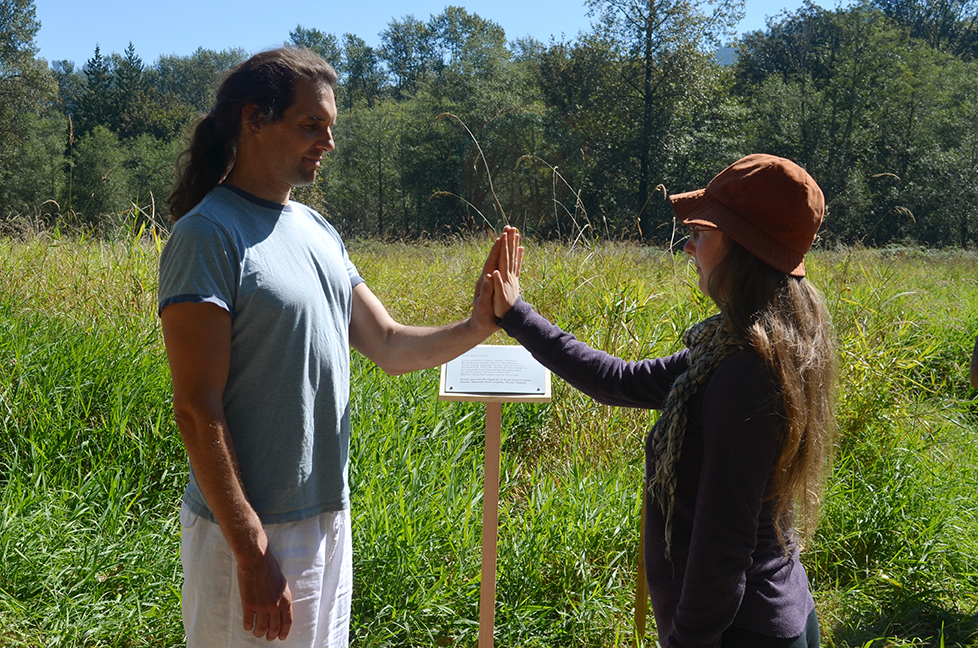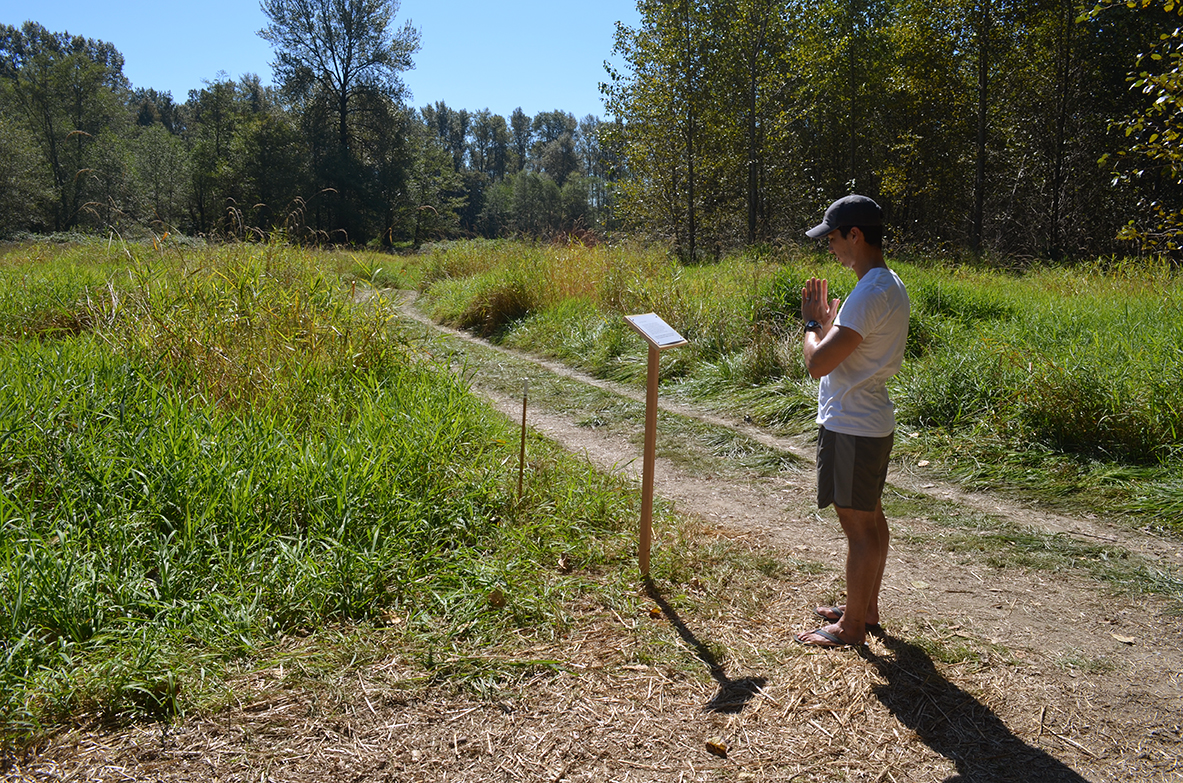After each Because You Are Here performance, audience members were invited onto the stage to listen to a story phone line, HEAR HERE WALLA WALLA, which we created in tandem with the performance as another means to in order to share excerpts from the featured interviews. The audience was also invited to talk with representatives from the Walla Walla Immigrant Rights Coalition, a community organization focused on ensuring the rights of immigrants through education, access to legal counseling and moral and social support services. After the Saturday matinee performance, the cast and a few interviewees who were willing to be identified joined the public for a discussion about the making of the work and the impact of the work on their individual and civic lives.
Guided by concerns
Excerpted from the final Because You Are Here (BYAH) performance script
Written by Donovan Olsen and the cast of BYAH (with alterations for this context by Tia Kramer)
Context: The Because You Are Here performance arose from a class which aimed to act as a collective response to the here and now. At the same time that we, the class, committed to collaboration, risk-taking, civic responsibility, and co-authorship of a socially engaged theater piece, we remained conscious of the ever-changing political landscape that surrounds us. While we are artists and students, we were seen as whole people and asked to bring forth our knowledge and experiences as such.
Six weeks ago, we gathered as a group to list our concerns regarding this project. They were numerous and nuanced and each concern we listed seem to spawn new and valuable considerations. Considerations that we vowed, as individuals comprising a larger collective, to bear in mind through the rest of our creative process in preparation for this show.
We worried that we would misrepresent voices. That we would let context go by the wayside. That the performance you are seeing here tonight would overshadow the process that has led us here. We worried that our focus on audience criticism might get in the way of our ability to take action. We questioned how best to honor the ten people we interviewed. And how to leave space for the millions of stories we are not telling here tonight—including the stories of at least eight people who wanted to be interviewed for this project but, for various reasons have not yet been—each with their own complexities and urgency and need to be heard.
We asked whether we were giving ourselves over with the same vulnerability we asked of the people we interviewed. As we raised this concern, Walla Walla resident Afrika Brown shared with us the following wisdom, informed by the work and writing of James Baldwin. She said,
“To stand and say that you will be the witness to another’s story makes you vulnerable because you are being trusted to tell a person’s story. You now bear some of the responsibility of the story. But in that place of vulnerability there is power because you can ensure that the story is not forgotten.”
How would we make this project into something that could endure?
The image above lists the values we wanted to prioritize in the making of this work.
Below are some of the questions and concerns we raised that November day. We decided to use these as guides. In this way, our concerns marked a path for our creative progress INSTEAD of becoming hurdles that might stop or prohibit action.
How do we emphasize that this show and process is relational?
Will it be accessible? And to who?
Can we create a performance that is for the interviewees AND the privileged Whitman community AND the HISPANIC/LATINX community? Is that impossible?
What if we don’t satisfy our interviewees?
What if we misrepresent voices?
How can we honor all the people who want to be interviewed by have not been interviewed?
Will we be able to illuminate the the struggles of the immigrants we interviewed while also sharing their strength, value and importance in our community?
How do we include collaborators in the final stages of the process without creating arbitrary pressure on the creative work or the collaborators themselves?
What if we won’t/can’t adequately maintain relationships with interviewees?
Have we, the artists, recognized our own vulnerabilities ENOUGH? Have we made ourselves vulnerable enough?
What role should language translation/interpretation play in this project?
What if we translate too much of our content into English? What if we translate too little of it?
How can this show benefit the COMMUNITY and not just those of us who are creating it and Whitman College as in institution?
Which collaborators have we not fully engaged? If wrong doing was done can it be mended?
How do we cope with the fact that we can not produce a show on this topic that is somewhat ethically problematic? Can we be ok with that imperfection and still proceed?
If we don’t do this work, who will?
What if we allow context will go by the wayside?
How might our own bias’ and blinders (those we have because of our privilege and context) create a problematic framework for this show?
What are the consequences of our our actions? Do they impact our egos or the people we have interviewed more?
Can we do no harm?
Who is the target audience? Who is OUR target audience? Who are the interviewees’ target audience?
What format or form does the play need to meet the requirements of Harper Joy Theatre? What are the limitations of HJT? Can these be addressed?
How can/could we bring in partnerships beyond those we have already engaged?
How can we expand the audience, the people who are actually in the room, beyond the typical Whitman Harper Joy Theatre audience? Can we get people to the theatre who do not normally come to the theatre?
If we put effort into expanding our audience and making the show accessible, should we continue that effort for other shows and shouldn’t that impulse go beyond that effort.
What if we don’t have the time to expand our audience and the accessibility of the show? If we won’t do the work to actually be effective, will it happen?
What are the barriers that might prevent Whitman campus to see the show?
Is childcare a barrier for our intended audience? How can we provide child care for the show?
Is language a barrier for our intended audience? If we provide Spanish translation for the show will it be utilized?
What if we cater to an audience that does not know Spanish while advertising to an audience that has to get by on a language they don’t feel comfortable with?
What if there is unexpected backlash to the show? What if that backlash hurts our co-creators and/or the people we are trying to share the stage with?
What if we over emphasize the performance and not the process?
What if work gets critiqued as an end product rather than a process? What if the perception of of the show by “others” is over emphasized?
What if audience members are so bent on critiquing this that they won’t receive it? It is easier to critique than to receive?
Can we guide and help the audience to be generous?
How can we avoid getting stuck in our heads?
How do we create a project that endures beyond the show itself?
MORE: RESEARCH (from THE LAB)
or find posts from all categories of THE LAB below.
May this practice be of benefit
As a part of the Because You Are Here process our collaborative team employs rituals to help us transition in and out of rehearsals. We look to these rituals to continually remind us why we are in the room together, to acknowledge each persons contribution and to extend gratitude for everything that made our work together possible. Our collective “clap out” is the most notable of these rituals.
At the end of each rehearsal, we gather together (each and every person in the room is invited to participate). Standing in circle, we all find stillness. In this space we express hope that the work that we do is of benefit. Then, listening to each other (with no individual leader) we all clap our hands at the same time then we throw the clap up sending our hope out into the space.
This ritual has become a glue, tying us to the present moment, the context of our work, and each other. It is often filled with joy, relief, and laughter.
Video filmed by Tia Kramer for a project titled, “I said yes” by collaborator Erina Horikawa
MORE: ACTIONS (from THE LAB)
or find posts from all categories of THE LAB below.
The Red Square
In the process of devising performance, Jessica Cerullo and I have been strongly influenced by the teaching of Barbara Dilley. Dilley, one of Jessica’s mentors at Naropa University, is most known for her development of Contemplative Dance Practice (CDP) a widely used open form movement practice that we employed weekly during the Because You Are Here process. Barbara Dilley also taught a composition technique called “The Red Square” which was invaluable to our student collaborators as it encourages performers to mindfully consider their bodies in relation to the space they inhabit.
A thick red rope “is laid down on the floor, our gaze rests with the room and the Square. Nothing much is happening. Just waiting. Then something comes. “Like a fish leaping from water,” we see in our minds eye a glimpse of our self in a still posture in the Square. We rise up, walk into the Square, and inhabit what we see.” - Barbara Dilley from “This Very Moment: Thinking, Teaching, Dancing" p171
After each person has a chance to try out a Solo once or twice or two dozen times, we began with Duets. “Duets begin with someone in a Solo posture. Because you see that person in the space, where do you see yourself? Go to this image. Settle. Allow a moment for both postures to be seen [by the onlookers and well wishers.] Let the first person ‘peek” after the second one arrives. Let them see what they have inspired! It’s important to acknowledge influences. Now dissolve and leave.” - Barbara Dilley from “This Very Moment: Thinking, Teaching, Dancing" p173
After practice with these forms one can add “allies”-objects, prompts, lights, text and sound. You can also introduce a directors chair in which various participants sit and take on the role of giving out guiding instructions. We also expanded the experimentation into improvisations within the room as a whole in which we respond, moment by moment, to partners and in quartet.
MORE: ACTIONS (from THE LAB)
or find posts from all categories of THE LAB below.
Magic in the mundane?
Over the weekend, I walked with my friend and collaborator Shoshana Gugenheim from the Portland Steel Bridge, on the corner of NW Oregon Street and Interstate Way, to Director's Park in the heart of Portland's downtown. We walked shoulder-to-shoulder, in-step, in silence. Like one entity, my left hand was at my side, still, mirroring hers which rested on a satchel. My right hand felt the momentum or her right hand, together they swayed with intention propelling my feet forward. Right. Left. Right. Left. Both of us keenly aware of the other and our surroundings. Both of us listening and absorbing: The smell of coffee from a cafe on the corner. A woman's perfume. A loud conversation about tomorrow. A crow swooping down to land on the top of a lamp post. I heard the gentle tap of it's claws touching the aluminum armature as a truck passed, thundering down Taylor Street. Negotiating directions and intersections, a change in elevation and traffic felt curious. When we walked beyond each building's shadow, sunshine filled our eyes. Together we squinted. Left and then right. Left then right.
We were experimenting, playing, wondering...actively wandering. How do we inhabit public spaces? What does civic engagement mean? What are the political consequences of our presence? What are the consequences of public silence? What would it be like to walk together, in-step through the bustle of a city? What would it require to remain together? Would anyone notice our unity? What does it mean to combine our efforts? Combine, at it's linguistic origin comes from the prefex "com," which shares it's meaning with "co," means with or together and "bine" means two. Two people. Two sets of arms. Two pairs of legs. Two bodies. Together.
Last February, during our "Walking Tour of the Olympic Sculpture Park," Eric Olson and I publicly shared a set of scores or simple instructions that were set to site-specific sculptures or places throughout the park. Standing on a walking path just a 100 feet from Jaume Plensa's 2011 sculpture Echo we instructed the audience to, "Identify a rhythm in your environment. Using your voice or body, echo this rhythm. Repeat. As we walk toward the sculpture spontaneously repeat."
Photograph by Jonathan Vanderweit. Orbiting Together. Seattle Art Museum Olympic Sculpture Park. 2018
In this period of listening, mirroring and echoing I found myself giggling with Celia, a 4 1/2 year old friend of mine. Her little feet pattered on the pavement with certainty as she grinned up at me. With focus, I smiled back at her and tried (with all my might and attention) to step in sync. My short steps and her big steps, my foot lightly settling to the ground, matching the sound of her confident stomp.
While walking with Shoshana, I recalled this moment. Sometimes the inspiration for my future work is hidden in my body. I only see it when I am brave enough to act on my vision, impulse or intuition.
MORE: ACTIONS (from THE LAB)
or find posts from all categories of THE LAB below.
What's your problem?
Deep in the throws of research for a new project and I came upon this Ghana Think Tank Assignment. Maybe I should employ their assignment to address my question:
How can I use acts of empathy and connection to address specific needs here in my community in Walla Walla?
MORE: RESEARCH (from THE LAB)
or find posts from all categories of THE LAB below.
Sigh. Observe whether anyone noticed. Repeat. (COSMOS 1536)
SENT VIA SATELLITE TRIGGERED TEXT MESSAGE on 1/31/17 at 8:58am.
FACT: COSMOS 1536-Zenit was a series of military spy satellites launched by the Soviet Union between 1961 and 1994. To conceal their nature, all flights were given the public Kosmos (Cosmos) designation. Dozen's of spy satellites orbit overhead daily.
*FEATURED IMAGE is of COSMOS 122: Maquette du satellite météorologique russe (1966), Musée de l'Air et de l'Espace, Paris Le Bourget (France). Obtained on Wikipedia Media Commons
Do you find meaning in these actions?
The week following our Orbiting Together project launch at the SAM Olympic Sculpture Park has been a... learning process. Recently, I heard a colleague say, "The aim is to make a project seem so simple and accessible that it appears as if it could have been pulled off overnight. Yet, the truth of the matter is that the behind the scenes work for these socially engaged projects is belabored." I have been feeling that labor. And because the timeline for this project is breakneck, that labor is exhausting and has taken an emotional toll; maintaining conceptual rigor while maintaining simplicity and clarity has almost been an out of body experience. Given the subject matter and content of the project as a whole, I find that ironic.
All that said, when today's text appeared, I experienced the magic of this project for the first time. I felt as if the words arrived serendipitously, from the cosmos, ESPECIALLY FOR ME. It was personal and intimate. I happened to be standing across from artist and director, Jessica Cerullo, in her vocalization class. She received the text at the same moment, a huge grin filled her face. For some time we sighed as if passing the sigh back and forth in call and response. In between each exhale we slyly looked around the room at the students filing in, carefully observing them. In-the-moment-ness filled our bodies. And then, without saying a word we both went to sit at the circle forming in the middle of the room.
Today, I needed those words. And, based on the participation and feedback, it seems that others needed today's instruction too.
Today, the project felt complete and successful just for what it was.
MORE: ACTIONS (from THE LAB)
or find posts from all categories of THE LAB below.
Social Works
I've been reading....
(left to right; top to bottom)
Float: Variations on the Right to Remain Silent by Anne Carson
The Lure of the Local by Lucy R. Lippard
The Choreographic by Jenn Joy
What We Made by Tom Finkelpearl
Choreographing Difference by Ann Cooper Albright
Draw it with your eyes closed: The art of the assignment by Dushko Petrovich & Roger White
Performing Monuments by Mechtild Widrich
One Place After Another by Miwon Kwon
Theory/Theater: An Introduction by Mark Fortier
Small Acts of Repair by Goat Island
Standing in Space by Mary Overlie
Social Works by Shannon Jackson
This Very Moment by Barbara Dilley
School Book 2 by Goat Island
How am I different because you are here?
MORE: RESEARCH (from THE LAB)
or find posts from all categories of THE LAB below.
Who do we choose to let in?
Since September, I have been spending one morning a week meditating with inmates at the Washington State Penitentiary. Our sits occur in the chapel. Before entering through security I lock up my belongs: car keys, phone, wallet, hair clips, scarves (and other items which could be used as a weapon against me). Then I exchange my ID for a red badge with my picture on it. Inmates are separated by security level and if necessary their gang unit. Some weeks, I sit with the men in minimum security. The air inside the concrete passageways before and after each checkpoint is cold and stagnant. Other weeks, I sit in medium. Here the passageways are outside in the elements, surrounded by mazes of chainlink fences and razor wires. We pass through numerous gates: #8, #9, #32, #29, #17, #16. As if inside a institutionalized forrest, I could not yet find my way out without my guide. I haven't honed my instincts enough, yet; maybe next week. At each juncture, one of many gates slide open as if by magic. Security observes us from above. Two females slowing walking, careful not to move with too much purpose or mission; we wouldn't want to be seen as a threat. We are seeking an opportunity to sit in silence with a group of men who label this as some of the only silence they experience inside this fortress.
I've continued my work with the five silent structures of Fort Lawton. Videographer Jack Leonard has rendered old video I took in 2015 to create a mock-up of a four channeled installation. Each video will be projected on one of four walls of an enclosed room. When you step inside the room you would be virtually transported outside, surrounded by the four walls of a structure whose exterior is publicly maintained with care and yet whose interior is inaccessible and uninhabitable. The doors are locked with a dozen deadbolts. The windows have metal and plexiglass facades. Where I am able to peer through the foggy yellow plexiglass, I can see the floors inside covered with broken glass, dust so think it looks like dirt and cobwebs, so many cobwebs. The air inside must be stagnant. I wonder, should the final videos be filmed during four different seasons? I wonder, do pedestrians ever consider the silence inside these structures. And I wonder, is representation enough for me?
What would make absence more visible? What would cause a person to pause and question how permeable there own interior world is to the external one? What might inspire someone to question personal, structural and systematic incarceration? And would they consider the actions that led to this moment?
Who do we choose to let in?
MORE: TESTS (from THE LAB)
or find posts from all categories of THE LAB below.
How do we 'respect'?
While at the Washington State Penitentiary this past week, one of the inmates shared an acronym that he uses daily. These are words he lives by and hopes his kids will too. I find it to be a powerful guide for those of us who do creative social practice work within communities.
RESPECT
R - Relax
E - Explore
S - Smile (welcome people in and accept them)
P - Participate (engage fully)
E - Evaluate (assess your impact)
C - Compensate (adjust based on your evaluation)
T - Teach (share what you learn)
Shared with his permission. By request, he remains anonymous.
MORE: RESEARCH (the LAB)
or find posts from all categories of THE LAB below.
Rest
Why do you hurry? What are you hurrying toward?
I have come to see the necessity for creative breaks... rest. For the past few months I've intentionally stepped away from the active process of doing my creative work. During this time, I focused on my internal somatic experiences and took the precious moments I typically to fill with creative problem solving, to respond to spontaneous curiosities. I've been reading books, working on our tiny farm of a back yard, chasing my toddler through the sprinkler, watching light refract through the water at the local pool, taking bike rides through wheat fields, meeting with friends, cooking, canning, eating fruit fresh of the tree, sitting, enjoying warm night air.... life things.
After these periods of rest, I see new creative projects emerge (often clearly formed) and I awe at how interconnected my creative work is with daily life. And how important it is to rest and let seeds germinate.
An aside: While doing research earlier today I happened upon this software/programing article that (is very dry and academic but STILL) stretches my imagination! "Accurate and Efficient Gesture Spotting via Pruning and Subgesture Reasoning"
MORE: ACTIONS (from THE LAB)
or find posts from all categories of THE LAB below.
12 (suggested) Acts
1.
Blow into a straw.
Blow into a straw submerged in a glass of water.
Blow into a straw submerged in a trickling stream.
Blow into a straw submerged in a pond.
Blow into a straw submerged in a quickly flowing river.
2.
Press your entire body against a parked car with its engine running.
3.
Place your throat against the belly of a dog
that is basking in a pool of sunlight.
4.
Pedel a bicycle
with your hands on the pedals.
5.
Locate a grassy knoll.
Position your body so that your back sinks into the earth,
and your head points downhill.
Take 10 deep breaths.
Move 10 inches downward.
With eyes open,
look to the sky.
Over your right shoulder.
To the space between your tailbone and the earth.
Over your left shoulder.
To the sky again.
Repeat, this time with eyes closed
and the bottom of your feet leading.
6.
At the grocery store, mimic the walk of the first person you encounter in the produce department.
7.
Turn on an electric toothbrush.
Gently press the bristles against the crown of your head.
Then the soles of your feet.
8.
Take a walk barefoot through a park.
Collect every fallen leaf, stick, seed, trash or rock
that touch your feet.
9.
Tie a string to your ring finger for 24 hours.
Every time you notice it's presence:
a.) pause
b.) notice the temperature of the air against your skin
c.) imagine that the nearest stranger's movements release the tension in every muscle in your body.
Return to your previous task.
10.
Go to a coffee shot. Buy a cup of coffee. Find a seat alone.
Once seated begin to drink your beverage. After each sip,
re-position your sits bones by moving less than a 1/4".
11.
Lay on your back on a carpet floor. Clasp your bag, satchel or purse
in your arms. Roll about without allowing it to touch the ground.
12.
Breathe.
Dedicated to to Nickels Sunshine and the Spring Whitman Somatics cohort.
Written in May, 2017
MORE: ACTIONS (from THE LAB)
or find posts from all categories of THE LAB below.
A tour at the pace of my 1.5 year old
Six months ago, I moved to Walla Walla with my partner and one year old son. Walla Walla is a vibrant small town in rural Eastern Washington, nestled among expansive agricultural fields and the Blue Mountains. The pace of life here is unhurried. And the pace of life with an 18 month old is dawdling.
What if I were to give a tour of my town, my new neighborhood as I experience it?
MORE: TESTS (from THE LAB)
or find posts from all categories of THE LAB below.
Operation: GRASP
In 1906 George Bunker Gilbreth designed the Georgetown Steam Plant. Based on a field of research he and his wife Lillian pioneered called the "Study of Time and Motion," they studied the body at work. They isolated the body's gestures into elemental parts (which they called "therbligs"). Later they utilized (or tried to utilize) this knowledge of the body to design efficient systems/processes and industrial spaces that optimized work flow. They collected film, made photographs, wrote books, gave talks and transformed the future of what we now call our industrialized nation.
In 2014, I became fascinated with both the Gilbreths and the Steam Plant. The couple, the Gilbreth's, dedicated their lives to de-contextualizing gestures (ephemeral actions) for the sake of optimization. This was before the assembly line. Work was done slowly. They studied collections of minuscule moments and questioned how we could re-arrange them to be better... to eliminate pain in the body, to optimize effort. Initially this wasn't for the sake of the economy but rather so we had more time for happiness.
And then, then there is the steam plant. The Georgetown Steam Plant was designed to be "cutting edge" and yet now it is a huge, inefficient monument for fleeting moment in time. It's gorgeous, dirty, cold in the winter and summer, wet when it rains hard, vast, resonating with the sound of aircraft over head and your footsteps under foot. And it is still. Very still. You can feel the time invested in each detail of it's creation and the affects that lack of care have had over time.
Collaborating with choreographer Tamin Totzke we began to ask:
How could the body translate these layers of this history?
What role do George and Lillian's "therblig" gestures have on contemporary occupants of the vacant steam plant.?
How do we reveal answers to these questions within our bodies?
In May of 2015, with a group of skilled performers, we began problem solving. Guiding the group from the outside (behind the camera in this instance) I recited basic therblig directives. This improvisational operation:
Collectively enact each of the Gilbreth's 18 elemental gestures of efficiency and inefficiency.
Years later I still find myself thinking about these operations... The collective flocking. Arms, hands and fingers plucking at the air. Bodies lifting invisible loads. Physical touch. Intimacy. Task oriented assignments decontextualized from the task but contextualized in the space that the-study-of-the-task designed.
MORE: ACTIONS (from THE LAB)
or find posts from all categories of THE LAB below.
Time out for happiness
"The Gilbreths [created systems for more efficient labor because they] wanted the increase in productivity to result in greater happiness for all. After all, if we are saving time by being more productive, what will we do with all the extra time or goods produced? We should use them to be happy, owners and workers alike." -David Merkel
Georgetown Steam Plant workers in early 1900's. Seattle, WA
MORE: RESEARCH (from THE LAB)
or find posts from all categories of THE LAB below.
18 types of elemental motion
An excerpt from Wikipedia (Feb 26, 2015):
Therbligs are 18 kinds of elemental motions used in the study of motion economy in the workplace. A workplace task is analyzed by recording each of the therblig units for a process, with the results used for optimization of manual labor by eliminating unneeded movements.
The word therblig was the creation of Frank Bunker Gilbreth and Lillian Moller Gilbreth, American industrial psychologists who invented the field of time and motion study. It is a reversal of the name Gilbreth, with 'th' transposed.
A basic motion element is one of a set of fundamental motions required for a worker to perform a manual operation or task. The set consists of 18 elements, each describing a standardized activity.
Transport empty [unloaded] (TE): reaching for an object with an empty hand. (Now called "Reach")
Group (G): grasping an object with the active hand.
Transport loaded (TL):moving an object using a hand motion.
Hold (H): holding an object.
Release load (RL): releasing control of an object.
Preposition (PP): positioning and/or orienting an object for the next operation and relative to an approximation location.
Position (P): positioning and/or orienting an object in the defined location.
Use (U): manipulating a tool in the intended way during the course working.
Assemble (A): joining two parts together.
Disassemble (DA): separating multiple components that were joined.
Search (Sh): attempting to find an object using the eyes and hands.
Select (St): choosing among several objects in a group.
Plan (Pn): deciding on a course of action.
Inspect (I): determining the quality or the characteristics of an object using the eyes and/or other senses.
Unavoidable delay (UD): waiting due to factors beyond the worker's control and included in the work cycle.
Avoidable delay (AD): waiting within the worker's control which causes idleness that is not included in the regular work cycle.
Rest in peace (R): resting to overcome a fatigue, consisting of a pause in the motions of the hands and/or body during the work cycles or between them.
Find (F): A momentary mental reaction at the end of the Search cycle. Seldom used.
MORE: RESEARCH (from THE LAB)
or find posts from all categories of THE LAB below.
A response to my sketch: between
In early May, I shared a sketch titled, between. As further response to and exploration of the questions that lead to that work, I composed the following piece employing Anne Carson's 'short talk' poetry form. The work consisted of a plaque, posted on an informational sign post situated at the intersection of two diverging paths. This sign post was one of a series of 10 for a piece titled, Short Talks, Short Walks that was displayed at Smoke Farm for the Lo-Fi Arts Festival // Ad Hoc. An intimate performance corresponded with each post and was enacted during the festival.
Short Talk on Pairs
Socks are worn in pairs, usually matched.
Brackets are always used in matched pairs.
When writing, brackets can be used to inject or
set apart text. They can denote an idea related to
but separate from the original idea discussed.
Empty brackets indicate omitted text.
Before I leave the house I put on my shoes.
Press your hands together in front of your chest.
Pause. Separate them slightly. Pause. Repeat.
MORE: TESTS (from THE LAB)
or find posts from all categories of THE LAB below.
Silent structures: A performance score
The following text is an excerpt from the performance score for my Aug, 23 2014 work, Five Silent Structures.
1. How do our daily rituals activate a building?
2. What is lost when a space is constrained?
3. How does a structure (a home, a shelter, a refuge) transform our bodies.
4. How do our bodies and the spaces we inhabit break silence?
The body is: building. structure. flesh. waiting. being. past. future
The building is: body. structure. canopy. awaiting. being. history. tomorrow
The body is a building. A building is a body.
We are extensions of the buildings we inhabit, the places we know through repetition and time. Through our daily lives we enact the process of being with these spaces. Through this performance we will enact the process of being with these spaces attentively. The Fort Lawton structures are restricted, vacant, and empty. They contain histories of use but are now silently observing the world, patient and overlooked by most. Create silent spaces in yourself that mirror the spaces within these buildings. Stand with them as you might stand with a dear friend experiencing deep struggle, a family member undergoing incarceration, or a loved one incarcerated: constrained by limitations that prevent them from enacting their basic humanity. Become observant, patient, perceptive, generous, and open.
HISTORY: Fort Lawton is a place of watch. To be of watch over the sea. To protect. To guide. A community which shares a single mission.
AIMS: Listen. Observe
PROMPTS:
-Move in straight lines
-Stop, slow. Turn. Always use intentional rotation
-Non-striving
-Eyes slightly downward OR on the structure
-With each turn, minimum 30 seconds still. Only head and eyes shift, slightly and intentionally
-Once a parallel begins, must move the entire duration of a structure. Keeping distance between the same at all moments
-Only look up/ at structure when facing it with your shoulders and heart
-Enter a door at an exact 90 degree angle. Be present with it, silent and non-moving for at least 30 seconds. Touch optional.
-Must leave building after approach?
-Be as a rolling video camera is: attentively and without judgement. Yet, have the investment of someone who knows each structure as a builder might, or a parent who birthed this structure and cares for it like a child.
"make meaning from the fragments we get, which are also all we get" -Anne Carson.
MORE: ACTIONS (from THE LAB)
or find posts from all categories of THE LAB below.
Short Talk on Housing
For days these words have been resting on my tongue, slowly dissolving.
The lines have begun to settle into my hips.
“Here is one thing you can do if you
have no house. Wear several hats -
maybe three, four. In the event of rain
or snow, remove the one(s) that get(s)
wet. Secondly, to be a householder is a
matter of rituals. Rituals function
chiefly to differentiate horizontal from
vertical. To begin the day in your house
is to ‘get up’. At night you will ‘lie
down’. When old Tio Pedro comes
over for tea you will ‘speak up’, for
these days his hearing is ‘on the
decline’. If his wife is with him you will
be sure to have ‘cleaned up’ the
kitchen and parlour so as not to ‘fall’ in
her opinion. Watching the two of
them, as they sit side by side on the
couch smoking one cigarette, you feel
your “heart lift’. These patterns of up
and down can be imitated, outside the
house, in vertical and horizontal
designs upon the clothing. The lines
are not hard to make. Hats do not
need to be so decorated for they will
’pile up’ on your head, in and of them-
selves, qua hats, if you have understood
my original instruction. ”
